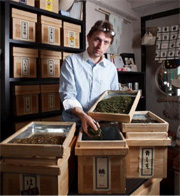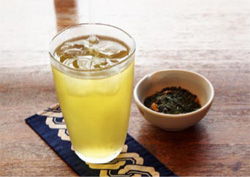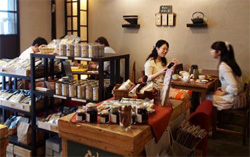Home > Highlighting JAPAN > Highlighting Japan JULY 2012 > Turning a New Tealeaf
Highlighting JAPAN
[SERIES] MASTERS
Turning a New Tealeaf
Stéphane Danton, who hails from France and is based in Kichijoji in the suburbs of Tokyo, is spreading the word about the allure of Japanese tea from a completely new perspective to those in Japan and around the world. Masaki Yamada interviewed Danton over one of his original teas.

Stéphane Danton holds up a tray of his peach-flavored tealeaves.
Credit: TADASHI AIZAWA
“The general perception is that Japanese tea tends to be preferred by the elderly, but a lot of young women visit our shop. By drinking the flavored teas that I have created, these women, perhaps, might be discovering brand new flavors and ways to enjoy Japanese tea,” says Danton.

A glass of cold Kyoho grape-flavored Japanese tea
Credit: TADASHI AIZAWA
“Just like wine, the flavor and fragrance of Japanese tea change ever so slightly depending on the source ingredient. This delicate characteristic of Japanese tea is what appeals to me. After working at the tea shop for some time, I started to wonder if there was a new way of drinking Japanese tea that could be translated to the rest of the world. But I barely had any knowledge of the types and source ingredients of Japanese tea. So I decided to visit tea-growing regions all over Japan.”
From Hokkaido in the north down to Okinawa in the south, Danton deepened his knowledge of Japanese tea by venturing to tea farms across the country, speaking directly with the producers and witnessing the conditions of tealeaves and trees on the plantations with his own eyes. This is how he happened upon Kawane tea, which is harvested in Kawane-cho in Shizuoka Prefecture, one of the leading tea-growing regions in Japan.
“I found Kawane tea to be the kind of tea that satiates my sense of sight, smell and taste, but felt that in its original state, it wouldn’t translate that well into sales overseas. There is a strong sense in the western world that Japanese tea equates to matcha and so it’s bitter. And the impression is that one cannot enjoy Japanese tea casually like wine. So this is how I came up with blending fruit aromas into cold-brewed Japanese tea; in other words, flavored Japanese tea.”

Customers enjoy flavored Japanese teas at Ocharaka in Kichijoji, Tokyo
Credit: TADASHI AIZAWA
In fact, I tried the Kyoho grape flavored tea. The subtle sweet and sour aroma of the grapes and the refreshing sensation were indeed something I had not experienced before in a Japanese tea.
“We sell flavored teas overseas on the Internet now, but orders from abroad only amount to around 10% of overall sales. I think there are various ways to grow sales. I am focusing on direct sales because I would like to communicate the stories behind Japanese teas to my clients: like the allure of their source ingredients or how they are transformed into merchandise. So my dream, first of all, is to open a directly managed Japanese tea shop in my hometown in Lyon. I would like to continue increasing the number of flavored teas as well.”
© 2009 Cabinet Office, Government of Japan






